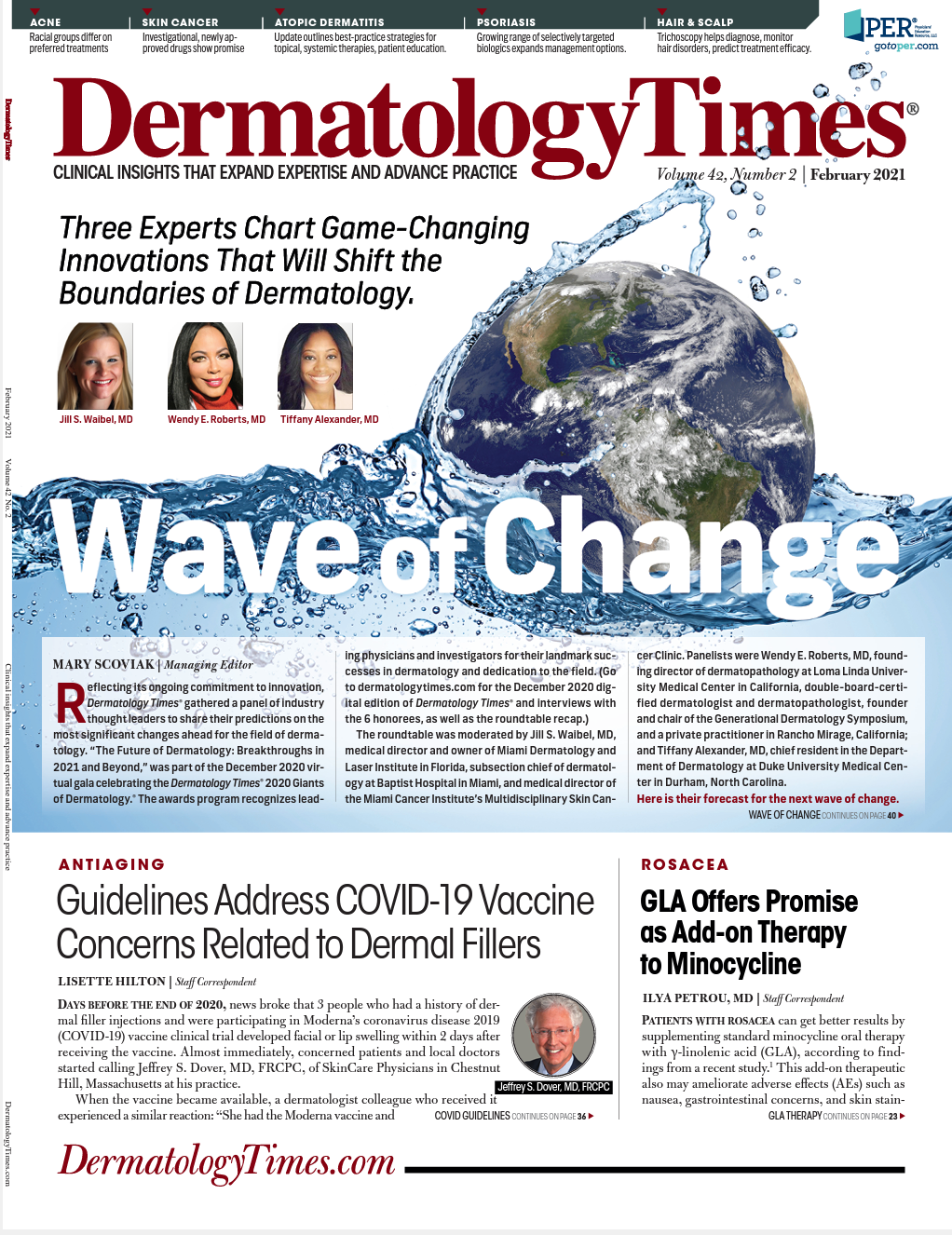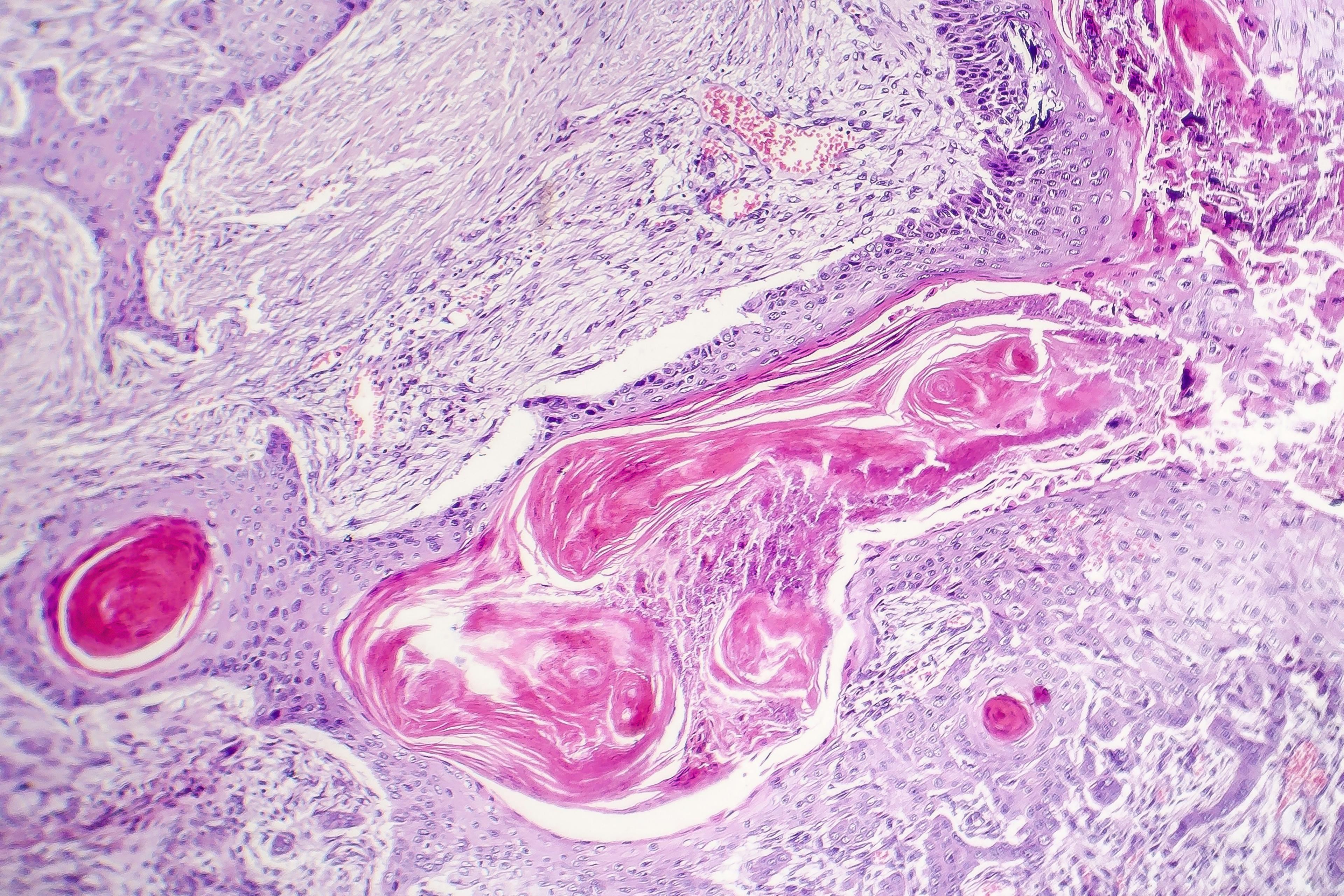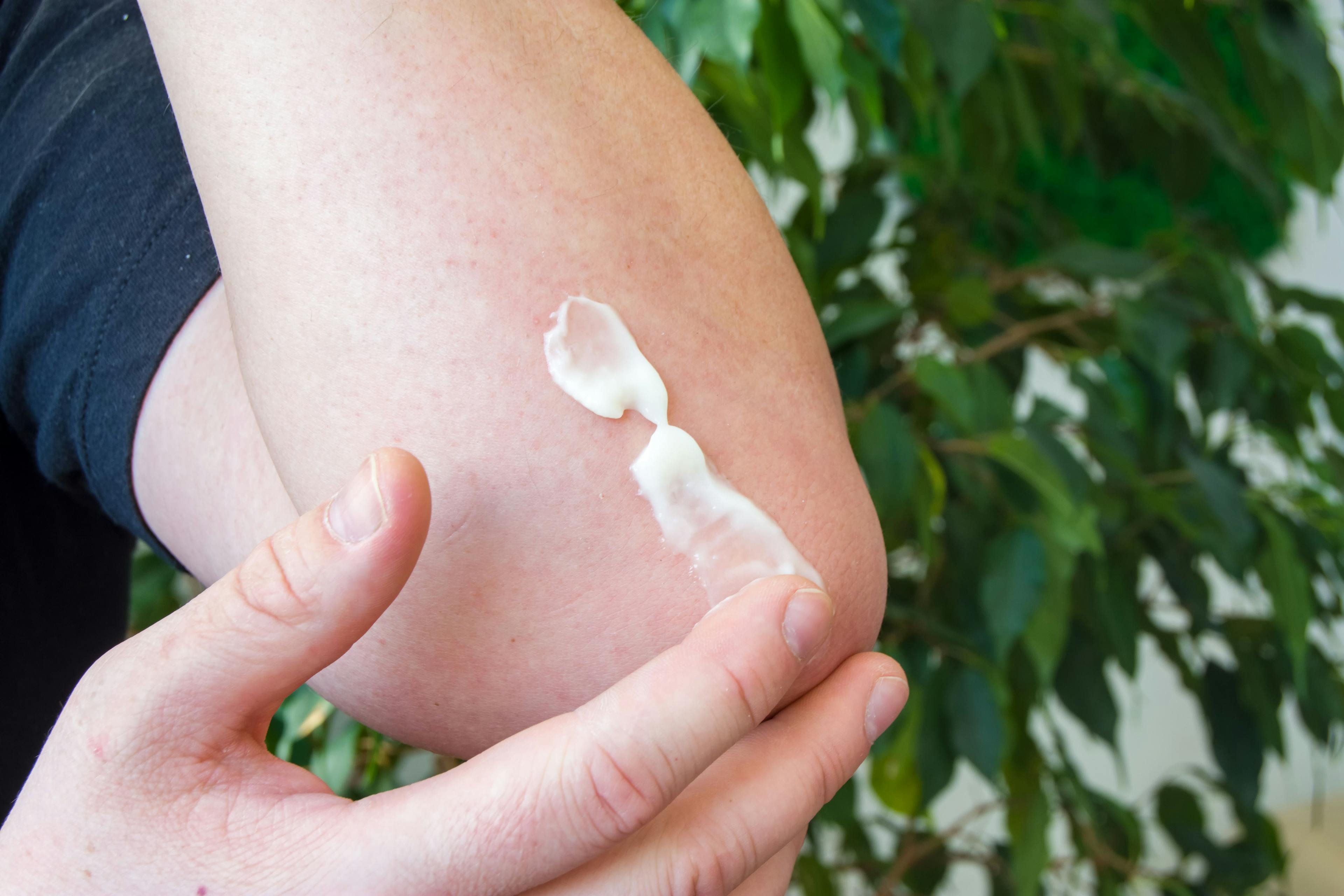- Acne
- Actinic Keratosis
- Aesthetics
- Alopecia
- Atopic Dermatitis
- Buy-and-Bill
- COVID-19
- Case-Based Roundtable
- Chronic Hand Eczema
- Chronic Spontaneous Urticaria
- Drug Watch
- Eczema
- General Dermatology
- Hidradenitis Suppurativa
- Melasma
- NP and PA
- Pediatric Dermatology
- Pigmentary Disorders
- Practice Management
- Precision Medicine and Biologics
- Prurigo Nodularis
- Psoriasis
- Psoriatic Arthritis
- Rare Disease
- Rosacea
- Skin Cancer
- Vitiligo
- Wound Care
Publication
Article
Dermatology Times
A Wave of Change Approaching for the Future Dermatology
Author(s):
Three experts chart game-changing innovations that will shift the boundaries of dermatology.
Reflecting its ongoing commitment to innovation, Dermatology Times® gathered a panel of industry thought leaders to share their predictions on the most significant changes ahead for the field of dermatology. “The Future of Dermatology: Breakthroughs in 2021 and Beyond,” was part of the December 2020 virtual gala celebrating the Dermatology Times® 2020 Giants of Dermatology. ® The awards program recognizes leading physicians and investigators for their landmark successes in dermatology and dedication to the field.
The roundtable was moderated by Jill S. Waibel, MD, medical director and owner of Miami Dermatology and Laser Institute in Florida, subsection chief of dermatology at Baptist Hospital in Miami, and medical director of the Miami Cancer Institute’s Multidisciplinary Skin Cancer Clinic. Panelists were Wendy E. Roberts, MD, founding director of dermatopathology at Loma Linda University Medical Center in California, double-board-certified dermatologist and dermatopathologist, founder and chair of the Generational Dermatology Symposium, and a private practitioner in Rancho Mirage, California; and Tiffany Alexander, MD, chief resident in the Department of Dermatology at Duke University Medical Center in Durham, North Carolina.
Here is their forecast for the next wave of change.
Q: Where do you see the most innovation in dermatology?
ROBERTS: The next big breakthroughs will be in skin cancer. We already use biologics to treat some skin cancers instead of relying only on surgery. We’ve moved from topical chemotherapy and oral chemotherapy injection to superficial radiation therapy. I’m excited about that imaging component, especially using imaging and ultrasound in combination with microscopy because we can image and treat. We’re going into the realm of multi-photon excitation.
ALEXANDER: I’m seeing more research on hair disorders in general and scarring hair disorders in particular, especially in regard to the overall number of women and the number of women with skin color affected by these conditions. Genetic-related causes are now areas of interest. Some study findings already have showed that genetic mutations that may play a role. There is a wider range of new treatments for scarring hair disorders, including plasma-rich platelet [PRP] formulations.
WAIBEL: I expect a huge jump in laser technology and devices that will go beyond the cosmetic arena into cancers and laser-assisted drug delivery, not just for dermatology, but for all specialties. We’ll also see innovation in other energy-based solutions. Artificial intelligence will contribute significantly to our understanding of our specialty and provide an assistive tool for diagnostic accuracy.
Q: Could you describe the biggest challenges ahead?
ALEXANDER: Getting insurance companies to approve some of the specialty treatments that benefit our patients is a major challenge. Take biologics: Many are phenomenal. Patients love them; their lives are changed. But doctors have to go through a lot of red tape to get insurance companies’ approvals...which can limit patients’ access to these treatments. Off-label use of medications is another concern. It can be difficult to get these treatments, so we may have to use compounding pharmacies. Keeping teledermatology alive and well is also an issue. COVID-19 [coronavirus disease 2019] made teledermatology a necessity for many practices. I think that’s great. It helps increase access for all patients. I’m just hoping it will last and that insurance companies will keep it on board.
ROBERTS: Telemedicine is great for providing accessible, affordable care. I love it for medication refills, among other things. But it has some inherent challenges. The toughest part is that it doesn’t replace a physical exam, which may mean that the patient has to schedule a second visit to come into the office if the condition warrants a physical exam or testing.
I agree with Dr Alexander about medications, prescribing, and the whole scenario of getting medications to our patients. Our specialty is looped out. We get medications after development. We need to be more involved in how these agents are bought to market.
I also agree that access is a major challenge. Our country really suffers from lack of access to dermatology. That’s something we have to work on—not only in terms of treatment but also preventive care. Skin disorders drive up the price of medicine nationally. If we could get into a more preventive mode, we could help lower the cost of medicine. A lot of patients can’t benefit from good medicine because they can’t afford it. We need to get our patients out in front of potential skin-related problems. Dermatologists’ access to devices and lasers is another issue. We want to use all the devices; we want to explore what’s possible. But access and economics often prohibit great devices from getting in the hands of great dermatologists.
WAIBEL: In parts of the country such as Indiana, where I grew up, there’s definitely an access problem. There are so few dermatologists that it may take a patient with skin cancer 8 months to get an appointment. By then, they may have stage III melanoma. In cities like Miami, where I practice now, we have scope-of-practice issues, especially in the cosmetic arena. I do a lot of scar work. I see patients who have been disfigured permanently or have pigmentation issues from nondermatologists who were not properly trained or did not understand the skin tissue interaction.
I’ve even had patients who died or committed suicide after problems with treatments administered by nondermatologists. Patients need to understand that a $200,000 laser plugged into 220 V is being used on their face. Sometimes, if the provider is poorly trained, the outcomes don’t turn out well. My heart just goes out to the patients and families when they get harmed by these technologies.
I share Drs Roberts and Alexander’s concerns about costs. I practice in-patient hospital medical and medical dermatology. Reimbursements continue to go lower for a lot of our medical-only colleagues; it’s getting to be very challenging. They can work with a patient for a year, and deductibles have not even been met. Patients can’t sustain that over time. We’re a smart group; we have to solve those problems.
Q: What will be the most exciting new products of 2021?
ALEXANDER: Biologics, particularly ones that may not have any adverse effects and may not require lab monitoring—there are so many for psoriasis. More are being developed to treat atopic dermatitis.
ROBERTS: [I look forward to] nano-pulse stimulation for the removal of benign lesions. I practice in the Palm Springs, California, area, and I see many patients with sebaceous hyperplasia and seborrheic keratoses. Until now, we’ve had only liquid nitrogen to treat these pesky lesions. Wouldn’t it be nice to have a cost-effective treatment that finally gets rid of them? I’m also interested in artificial skin or bioengineered skin.
WAIBEL: Stem cell research—our friends at Wake Forest University in Winston Salem, North Carolina, are growing new kidneys and bladders from a patient’s own cells in vivo and implanting them in the patient. Another is an invention one of this year’s Giants of Dermatology® honorees, R. Rox Anderson, MD, [professor of medicine and director of the Wellman Center for Photomedicine at Harvard Medical School in Boston, Massachusetts]. Dr Anderson is the chief medical officer and founder of Accure Acne. He and his team developed a novel 1726- nm laser that can achieve selective destruction of the sebaceous gland. I think we’ll be able to get some basic hyperplasia with that, as well. The device already has the CE mark in the European Union, and I think we’ll be seeing it on the market here this year.
Dr Anderson also worked on developing a combination of the punch biopsy and the fractional laser. For full disclosure, I was part of the clinical trials for this. The aim is to tighten the skin and soften wrinkles, but I truly believe we’ll be able to use it for acne scars, stretch marks, tattoos, and much more. I’m hoping to see that out in 2021, as well.
JAK inhibitors are also exciting, as Dr Alexander mentioned. These things are magical. You can take a patient with atopic dermatitis affecting 80% of the body surface area [and see the condition] clear in 2 weeks. I see potential use for vitiligo and alopecia. I think it’s going to help heart disease, lupus, and autoimmune diseases, among others.
Q:Do you observe new opportunities in dermatology?
ALEXANDER: I’m so glad to see efforts toward including skin of color and making images available. Not long ago, textbooks, presentations, even articles and PowerPoints didn’t include people with skin of color. That’s been brought into the light. A lot of strides were taken to improve that, like with VisualDX [diagnostic clinical support system], which now has a section with skin of color images. At Duke University, we have various lectures about skin of color and disorders that may affect that patient population disproportionately. Even for COVID-19, people are asking for images of patients with skin of color who have coronavirus-related skin because African Americans have been hit at such a high rate.
As mentioned before, teledermatology is opening up new patient markets through accessibility and affordability. For example, patients at Veterans Affairs medical centers now get reimbursed for telehealth visits. Before COVID-19, that was pretty rare. One of the few positive changes resulting from COVID-19 is that teledermatology is helping patients who may not have great access to dermatology get the care they need.
ROBERTS: Generational dermatology, which I define as a multidecade approach to treating the evolving aging patient, [is an exciting new area]. Most of us know our genetics. We can see versions of ourselves in our parents and grandparents. We can be skin smart, just like we’re heart smart. We know what’s going to affect our skin, and we need to start good habits earlier in our lives. For someone with a family history of hair loss, do we wait until they’re 40 and their hair starts dropping, or do we want to get ahead and maybe give them some PRP when they’re in their 20s and 30s, knowing that they’re at risk of hair loss? Think about not treating only the person who’s presenting. What about their sister, their brother, their mother, their grandmother? Think about bringing multiple generations into the house of dermatology and expanding the lens. We’re looking at those opportunities in my Generational Dermatology symposium (generationaldermatology.com).

Newsletter
Like what you’re reading? Subscribe to Dermatology Times for weekly updates on therapies, innovations, and real-world practice tips.


























